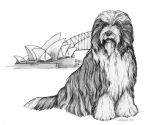Living With Beardies
LIVING WITH BEARDIES
PRESENTED BY
The Bearded Collie Club of NSW Inc.
History
The Bearded Collie was originally bred in Scotland as a sheep drover, although he has also been used as a butcher's dog and also worked with dairy cattle. The breed almost disappeared toward the end of WW2 but was revived in later years by a small band of enthusiasts who bred carefully using dogs found to be still prized as workers in their native home. Today the Beardie is a popular dog in Great Britain & America and is gaining popularity elsewhere in the world.
General Characteristics
A medium sized shaggy dog, the Beardie has a long, lean body covered with long coarse hair & and a soft dense undercoat. He should have a soft, wistful expression and an exuberant but gentle disposition. He should display neither nervousness nor aggression.
Beardies are intelligent and quick to learn. They possess a well developed sense of humor and will do just about anything for approval, although sometimes with their own special twist! A Beardie is a family dog and will not be happy if restricted to the backyard. He is usually extremely good with children & other animals and is not by nature a fighter.
Height - 50-55 cm [20-22 inches]
Weight - 20-25kg
Colour - Black, grey, silver, brown, fawn or tricolour with or without white markings. White should occur on the face as a blaze, on the muzzle, on the chest and forelegs and as a collar around the neck [but not behind the point of shoulder] and on the hind feet [not above the hock]. This is the ideal, maximum white allowed for a show dog however a Beardie's suitability as a pet is not affected by his colour or markings.
What to Look For ..
If you are looking for a show dog then a great deal of care should be taken in choosing the right dog. Go to shows, talk to breeders & be prepared to wait for the pup to suit you. If you are looking for a companion or obedience dog then you are looking for a dog which is sound in body & temperament. In both cases look at the parents [at least the mother] of each litter. This will give you an idea of what to expect from your pup. From the parents you should be able to judge the size your pup will grow, his probable temperament and his adult coat colour.
Look for a pup with free smooth movement. He or she should have a longish body and a level back. Don't be fooled by the fluffy coat - a pup may appear to be slightly high in rump but this should settle as he grows. Beardies should have a scissor bite but a level bite is tolerated. The pup you pick should appear well boned. He should have a healthy coat, bright eyes and an alert expression.
Choose a pup that responds readily when you talk to it. A Beardie should not appear nervous and should at least stand his ground.
Male or Female
If you are buying a Beardie as a pet & intend to desex him/her it makes very little difference whether you buy a male or a female. Male Beardies on the whole are not aggressive and either sex, if desexed as early as 6 months of age will develop into well adjusted adults.
Some people have a preference but unfortunately puppies cannot be made to order, the best pup in a litter may not be the required gender. If you do not intend to desex your Beardie, there are advantages & disadvantages to both sexes. You need to carefully consider your motives and discuss the issue with the breeder & your vet.
Development
Beardies are not mature until about 3 years old. During these first 3 years they change dramatically.
Puppies are born a solid colour [black, brown, blue or fawn] with white markings. Occasionally tan markings may develop a few days later. In the first 12 months they may pale out to almost white as their adult coat begins to grow [ some do , some don't ] As they get their adult coat they may look quite scruffy as they loose their puppy coat , sometimes all at once . This is quite normal and a respectable coat will grow in by the time your Beardie is 2 or 3. At 3 years old they should also be close to their adult colour although some may change colour almost their whole lives.
Teeth - Puppies usually begin to get adult teeth at around 16 weeks. If he had correct bite at 8 weeks he will probably have a correct bite as an adult but while teething everything will be changing and he may appear under or over shot for a short time.
